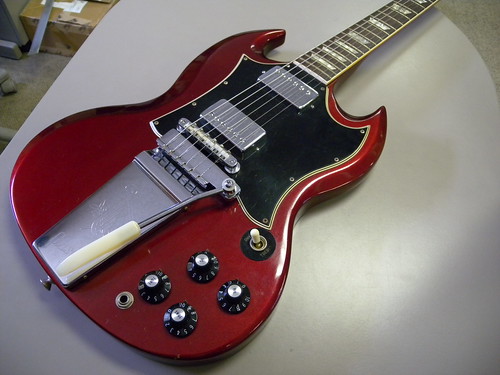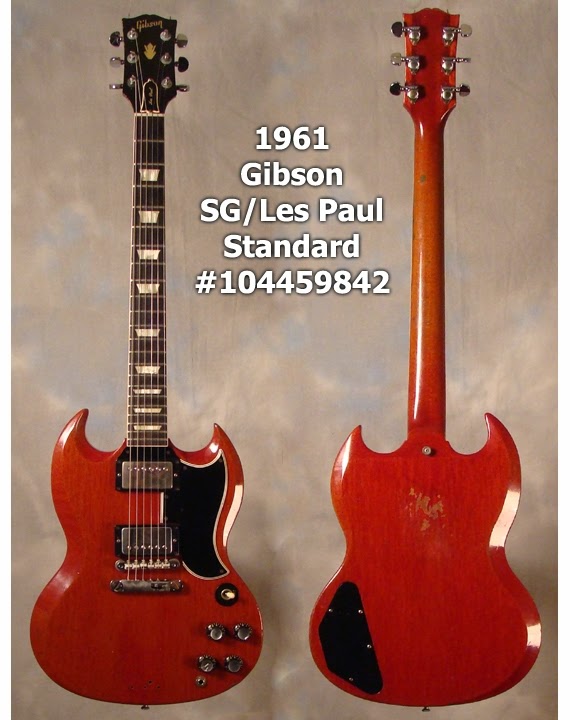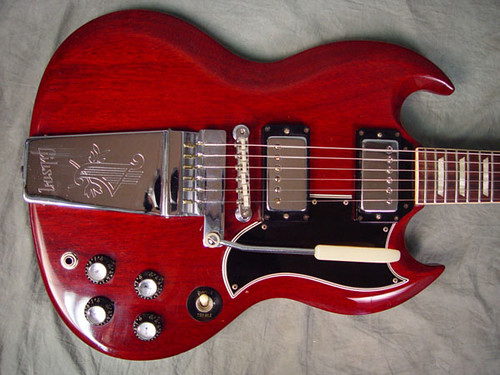By 1958, Gibson ’s sales of the various Les Paul Gibson , led by Ted McCarty
The Flying Vee, the Explorer and the elusive Moderne were all offered in 1959. But sales of these extreme instruments were dismal.Gibson was looking to produce a twin cutaway, solid body instrument, to boost sales and cut costs. McCarty came up with the Les Paul SG.
The Flying Vee, the Explorer and the elusive Moderne were all offered in 1959. But sales of these extreme instruments were dismal.
Originally, it was labeled The Les Paul SG, SG standing for solid guitar. It was flat-topped, with neck access to the last fret. The 24.75” scale neck joined the body at the 19th fret. The neck had a thinner profile than The Les Paul guitars. Likewise, the neck heel was very shallow.
The mahogany body was beautifully finished in cherry, as was the neck. The guitar came with a tune-o-matic bridge, a trapeze tailpiece or more commonly either a Bigsby vibrato or a Maestro side-to-side Lyre Vibrola.
The mahogany body was beautifully finished in cherry, as was the neck. The guitar came with a tune-o-matic bridge, a trapeze tailpiece or more commonly either a Bigsby vibrato or a Maestro side-to-side Lyre Vibrola.
This instrument was equipped with twin humbucking pickups, with volume and tone controls for each pickup and a Switchcraft 3-way selector switch.
However,
the guitar was dubbed The SG Standard.
The Les Paul SG outsold the Les Paul
If you recall, Les Paul
This was the close of the big band era.Gibson decided on a similar strategy for the Les Paul SG and came up with a fancy model called the Les Paul SG Custom. It came with a Polaris white finish and gold hardware, including pickup covers, tuners, the Maestro Vibrola, and its cover. This guitar had 3 humbucking pickups and an ebony fretboard, which was dressed with very thin frets, similar to those on The Fretless Wonder (Gibson Les Paul Custom). In fact, this guitar was dubbed by some, The Fretless Wonder.
This was the close of the big band era.
The bound fretboard came with block pearl position markers. The headstock was bound with a split trapezoidal inlay. It had the smaller 3-ply scratch plate that came on the cherry model, only it was white instead of black. This was a beautiful instrument; however most players are not fond of the thin fret wire that promised to make playing faster.
The small pickguard was offered through 1965. The neck joint was thickened in 1962 and in 1966, a redesigned neck joint was added, as was the enlarged pickguard, which aided in wiring the guitar.
One of the flaws in this guitars design was the thin neck joint. If the guitar was dropped, the headstock joint generally cracked, rendering it unplayable to be sent back to the factory for warranty work.
Late in that year, a larger pickguard was also added to the model. This surrounded both pickups.
One of the flaws in this guitars design was the thin neck joint. If the guitar was dropped, the headstock joint generally cracked, rendering it unplayable to be sent back to the factory for warranty work.
 |
| 1966 SG |
Other models came into being. They were all variations on the original design, but generally with less features.
A
All of these models came with rosewood fretboards with white dot position markers. The headstock had a Gibson decal and the tuners came with white plastic buttons.
The Gibson SG Special was a less stripped down version of the Standard. It featured one or two P-90 pickups with the usual controls. The neck was the same as the SG Jr. with white dot markers on a rosewood fretboard and a plain headstock. This model came with a tune-o-matic bridge and a stop bar tailpiece although it was made with an optional vibrato.
There have been numerous changes to the SG since the early 1970’s, which have included differing colour options, further changes to the fragile neck and changes to the pickguard and control placement.
Around 1980, Gibson had Robert Moog
The mid 1970’s a version was offered with carving in the body. The SG-100 was a budget version, in which the controls were mounted on the top under a metal cover. A limited run of The SG Standard3 was offered not too long ago. This guitar came with 3 single coil pickups, a single volume and tone control and a chicken head style knob as a pickup up selector switch.
In 1965, the Gibson Melody Maker guitar was reinvented with the SG shape and was available with one, two or three pickups and with or without a vibrato. Some people mistake the Melody Maker for an SG, however the pickups on this guitar are single coil with a plastic cover.
The original price for a 1961 “Les Paul ” SG standard was $310. This was similar to the price one would pay for a Fender Stratocaster.














3 comments:
This is a wonderfully informative article! I LOVE the Gibson SG - I had no idea it was 50 years old! Thanks for sharing :)
I really like your blog - I'm trying to get mine off the ground and was wondering if you could come check it out (and maybe consider following?).
http://www.guitartrump.blogspot.com/
Hope you have an *amazing* day! :)
Alex
Thanks GuitarTrump.
I've added my name. Nice blog.
For years Ive had this guitar body with a possibly mis-matched neck and I really want to finish this. It's an SG body and you can tell from screw holes that it had a whammy bar like the firebird VII I think with the plate, the real stumper though is its got a cavity for pickups and the controls in the front like a strat with everything mounted to the pick guard. Ive made a pickguard but I really want to figure out what kind of guitar this is. It might even be a knockoff SG. Somewhat reminds me of a Kzoo melody maker as far as the pickguard.
Post a Comment